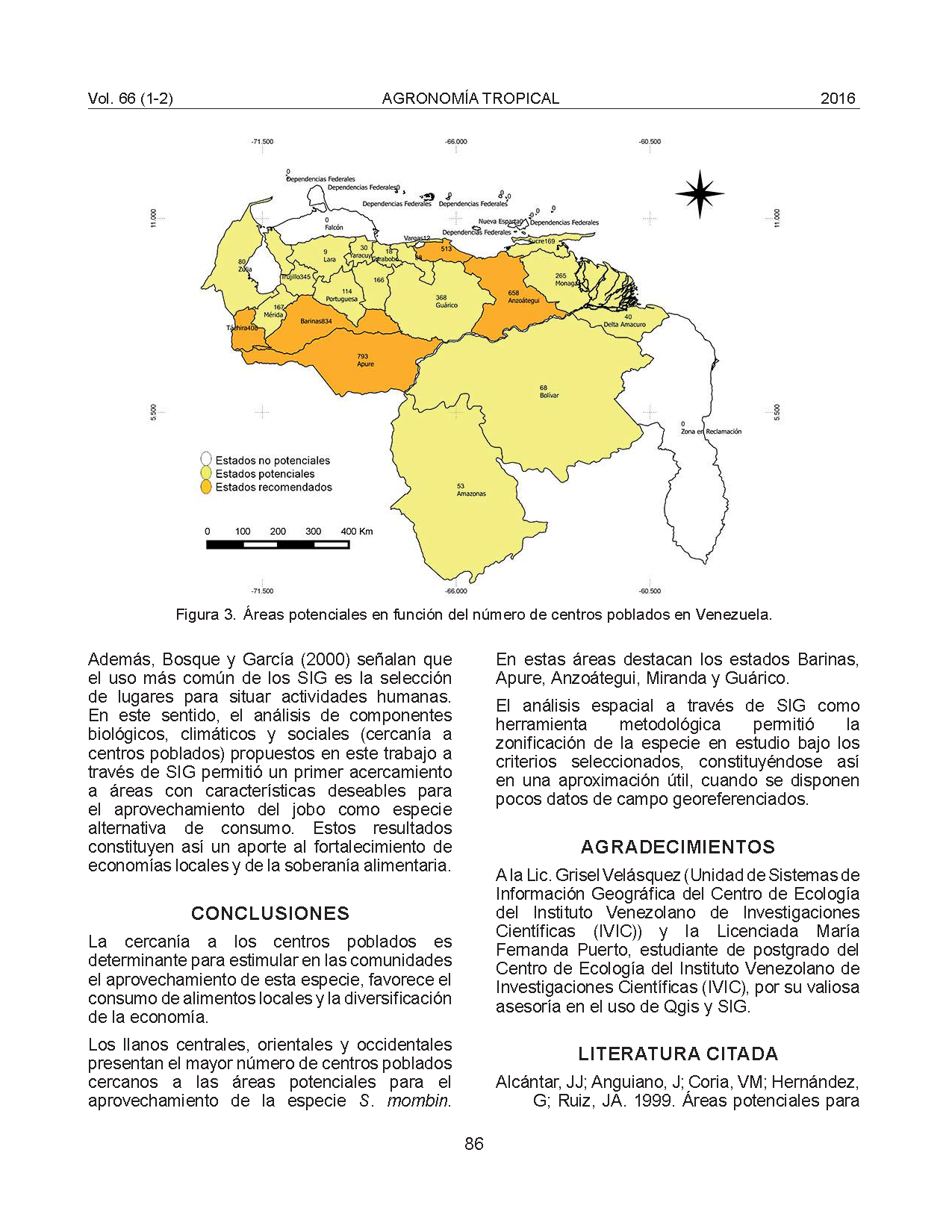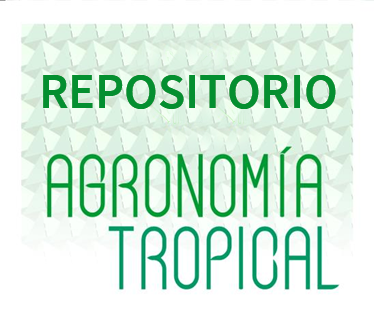Potential distribution areas of Spondias mombin L. in Venezuela through spatial analysis SIG
Abstract
Agrobiodiversity is one of the key elements for the food sovereignty of a country. Over the last 50 years, the model of agroindustrial production has driven our food-access to a stage of vulnerability. Along this period less species are used for our consumption, which implies the loss of knowledge about its management, requirements, and use. Venezuela has a wide variety of biogeographic regions (Andean, Amazon, Orinoquian, and Caribbean) and ample genetic resources, besides indigenous and farmers knowledge that give us a broad, potentially profitable agricultural diversity. However the food base of Venezuela, in terms of diversity is narrow and fragile to any crisis. For this reason, it is necessary to promote the use of species that have become naturalized and adapted to our biogeographical conditions that can be an alternative to diversify food consumption. The research aims to determine areas of potential distribution of Jobo (Spondias mombin L.) based on the characterization of areas where the species has been detected and selecting potential cultivation regions close to the most densely populated areas in Venezuela, using Qgis software. Twenty-one states with potential areas for the collection or cultivation of the species were detected in the country. However, based on the number of population centers the states of Barinas, Apure, Anzoátegui, Sucre, Guárico, Monagas and Miranda highlights among the most important.
Downloads
References
• Arce, AR; Monterroso, AI; Gómez, JD; Cruz, A.2017. Mexican plums (Spondias spp.): their current distribution and potential distribution under climate change scenarios for Mexico. Revista Chapingo (Serie Horticultura) 23(1):5-19.
• Bhag, M. 1994. Underutilized grain legumes and pseudocereals. Their potentials in Asia. Regional Office for Asia and the Pacific (RAPA). Food and Agricultural Organization of the United Nations (FAO), Bangkok, Thailand. 162 p.
• Bosque, J; García, R. 2000. El uso de los sistemas de información geográfica en la planificación territorial. Anales de Geografía de la Universidad Complutense 20:49-67.
• Bravo, M; Arteaga, MI; Herrera, F. 2017. Bioinventario de especies subutilizadas comestibles y medicinales en el norte de Venezuela. Boletín Latinoamericano y del Caribe de Plantas Medicinales y Aromáticas. 16(4):347–360.
• Burrough, PA; McDonnell, R. 1998. Principles of Geographic Information Systems. Oxford, University Press. 33 p.
• Ceballos, AP; López, J. 2010. Delimitación de áreas adecuadas para cultivos de alternativa: una evaluación Multicriterio- SIG. Terra latinoamericana 28:109-118.
• Dzendoletas, MA. 2015. Determinación y análisis de áreas de potencial conflicto en el uso del suelo en el ejido municipal de San Carlos de Bariloche, Río Negro, Patagonia, Argentina, utilizando la tecnología de los Sistemas de Información Geográfica (SIG).Memoria XIV Conferencia Iberoamericana de Sistemas de Información Geográfica, Parte II. Revista Ciencias Espaciales (Otoño) 8(2):227-242.
• FAO (Food and Agricultural Organization, Italia). 2001. Tratado sobre los recursos fitogenéticos (en línea). Consultado 20 jul. 2013. Disponible en prensa FAO en: https://bit.ly/2P5F6jw
• Francis, JK. 1992. Spondias mombin L. Hogplum. SO-ITF-SM-51. New Orleans, LA: U.S. Department of Agriculture, Forest Service, Southern Forest Experiment Station. 4 p.
• Galacho, FB; Ocaña, C. (2006). “Tratamiento con SIG y técnicas de evaluación multicriterio de la capacidad de acogida del territorio para usos urbanísticos: residenciales y comerciales”. En XII Congreso Nacional de Tecnologías de la Información Geográfica, 19- 22 de septiembre, Granada. 1509-1525 p.
• Hijmans, RJ; Cameron, SE; Parra, JL; Jones, PG; Jarvis, A. 2005. Very high resolution interpolated climate surfaces for global land areas. International Journal of Climatology (en línea). 25: 1965-1978. Consultado 20 jul. 2013, Disponible en: https://bit.ly/2u76YMJ
• Huber, O; Alarcón, C. 1988. Mapa de vegetación de Venezuela. 1: 2.000.000. Ministerio del Ambiente y de los Recursos Naturales Renovables. Caracas.
• GBIF (Global Biodiversity Information Facility). 2014. Consultado 18 jul. 2014. Disponible en: https://bit.ly/2vHaA8N
• INN (Instituto Nacional de Nutrición, Venezuela). 2010. Hoja de balance de alimentos 2010. República Bolivariana de Venezuela (en línea). Ministerio del poder popular para la alimentación. Caracas. Consultado 18 jul. 2014. Disponible en línea: https://bit.ly/39IMBEI
• Kostermans, AJ. 1991. Kedondong, Ambarella, and Amra: The Spondiadeae (Anacardiaceae) in Asia and the Pacific Area. Herbarium Bogoriense. Bogor, Indonesia. 100 p.
• Martínez, SM; Prieto, JA. 2014. Determinación de áreas potenciales para el establecimiento de plantaciones forestales comerciales en el norte de México. INIFAP. Folleto técnico número 47. Durango, Dgo., México. 35 p.
• Martelo, MT. 2003. La precipitación en Venezuela y su relación con el Sistema Climático. Venezuela: Dirección de Hidrología, Meteorología y Oceanología, Dirección General de Cuencas Hidrográficas del Ministerio del Ambiente y Recursos Naturales. Caracas, Venezuela. 72 p.
• Mayes, S; Massawe, FJ; Alderson, PG; Roberts, JA; Azam-Ali, SN; Hermann M. 2012. The potential for underutilized crops to improve security of food production. Journal of Experimental Botany 63:1075-1079.
• Miller, A; Knouft, J. 2006. Gis-based characterization of the geographic distributions of wild and cultivated populations of the Mesoamerican fruit tree, Spondias purpurea (Anacardiaceae). American Journal of Botany 93:1757-1767.
• Moreira, A. 1996. Los Sistemas de Información Geográfica y sus aplicaciones en la conservación de la diversidad biológica. Ambiente y desarrollo: Volumen XII- N° 2, p. 80 - 86.
• Muñoz F, HJ; Sáenz R, JT; García S, JJ; Hernández M, E; Anguiano C, J. 2011. Áreas potenciales para establecer plantaciones forestales comerciales de Pinus pseudostrobus Lindl. y Pinus greggii Engelm. en Michoacán. Revista Mexicana de Ciencias Fororestales 2(5):29-44.
• Njoku, PC; Akumefula, MI. 2007. Phytochemical and nutrient evaluation of Spondias mombin Leaves. Pakistan Journal of Nutrition 6(6):613-615.
• Padulosi, S; Hoeschle, I. 2004. Underutilised plant species: What are they?. LEISA 20(1):5-6.
• Padulosi, S; Heywood, V; Hunter, D; Jarvis, A. 2011. Underutilized species and climate change: current status and outlook. En: Yadav SS, Redden RJ, Hatfield JL, Lotze- Campen H, Hall AE, eds. Crop adaptation to climate change. Oxford, UK: Wiley- Blackwell:507-521.
• QGIS Development Team. 2009. QGIS Geographic Information System. Open Source Geospatial Foundation. Consultado 18 jul. 2014 Disponible https://bit.ly/37uuS2s
• Ramírez, BC; Pimienta, E; Castellanos, J; Muñoz, A; Palomino, G. 2008. Sistemas de producción de Spondias purpurea (Anacardiaceae) en el centro-occidente de México. Revista de Biología Tropical 56(2):675-687.
• Rodríguez, JP; Zambrano, S; Lazo, R; Oliveira, MA; Solórzano, LA; Rojas, F. 2005. Fronteras. 1era edición. Caracas, Venezuela. (en línea) Consultado 18 jul. 2014. Disponible en: https://bit.ly/2uXdCpl
• Scheldeman, X; Rojas, W; Valdivia, R; Peralta, E; Padulosi, S. 2003. Retos y posibilidades del uso de especies olvidadas y subutilizadas en un desarrollo sostenible. En: Memorias del XI Congreso Internacional de Cultivos Andinos, Cochabamba, Bolivia. p. 8.
• Tiburski, JH; Rosenthal, A; Deliza, RR; Godoy, LO; Pacheco, S. 2011. Nutritional properties of yellow mombin (Spondia mombin L.) pulp. Food Research International 44:2326-2331





